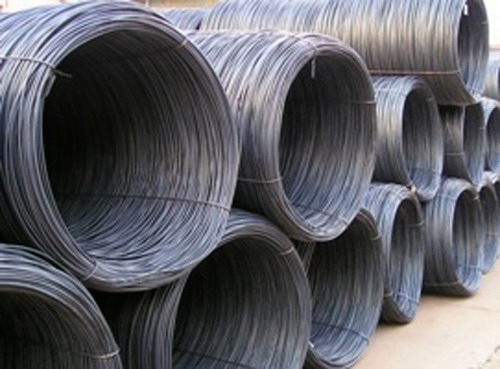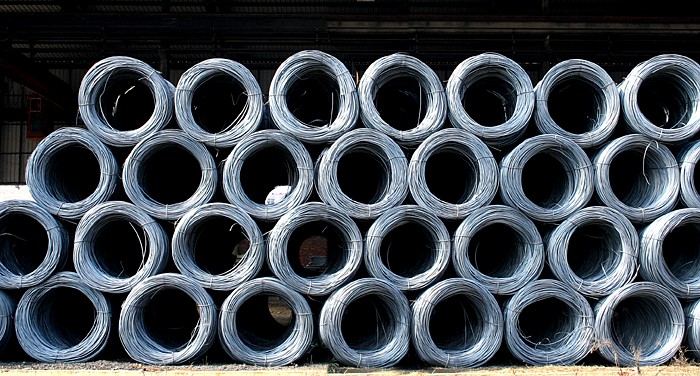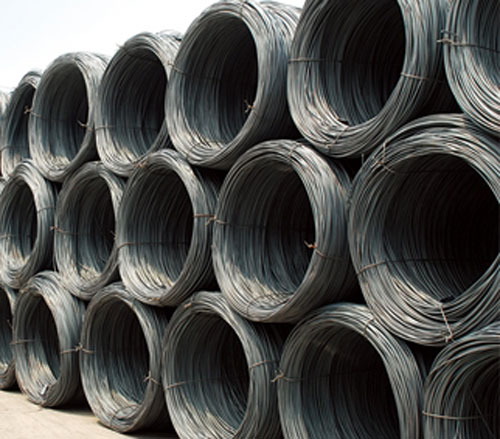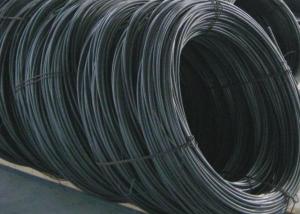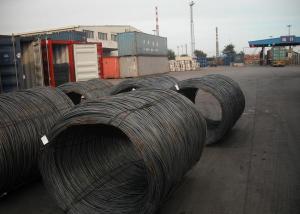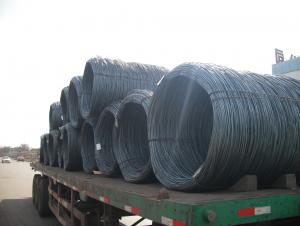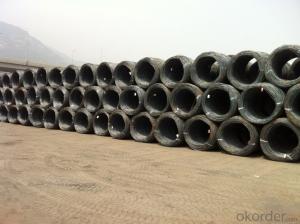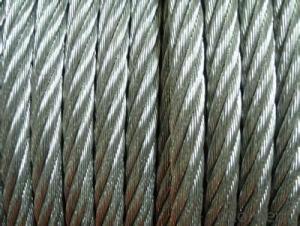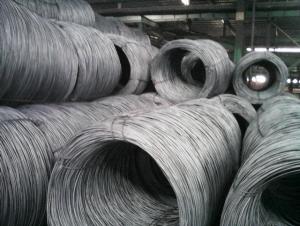hot rolled Wire rod
- Loading Port:
- China Main Port
- Payment Terms:
- TT OR LC
- Min Order Qty:
- -
- Supply Capability:
- -
OKorder Service Pledge
OKorder Financial Service
You Might Also Like
Product Description:
Specifications of Wire Rod Q195:
Steel Grade: Q195 Standard: ASTM, GB
Diameter: 5.5mm, 6.5mm, 7mm,8mm,9mm,10mm,12mm,14mm
6.5mm can be drawing into 2mm/8.0mm can be drawing into 3mm
Type: Drawn Wire in Coil, each coil weight about 2MT
Brand Name: N-RIVER Place of Origin: Hebei, China
Chemical Composition:
Please kindly find our chemistry of our material based on Q195 as below for your information
Trademark | Rank | Chemical composition (quality score) % | | ||||
C | Si | Mn | S | P | | ||
| | |||||||
| ≤ |
| ≤ | ≤ | | ||
Q195 |
| 0.06-0.12 | 0.30 | 0.25 | 0.050 | 0.045 | |
Trademark | Rank | Pulling Test | | ||||
Bend PointΔs/Mpa | Tensile Strength | Elongation Ratioδ5% | | ||||
| | |||||||
Thickness (Diameter) /MM | Thickness (Diameter) /MM | | |||||
≤16 | 16-40 | | ≤16 | 16-40 | | ||
≥ | | ≥ | | ||||
Q195 |
| 195 | 185 | 315-390 | 33 | 32 | |
Usage and Applications of Wire Rod Q195:
After hot-rolled the products shaped into coil and delivery as finished product, including round, square, rectangular, hexagonal and so on. Since most of the products are round, it is generally called wire rod. Carbon steel wire rod is widely used in construction and manufacturing. Carbon steel wire rod is mainly used for reinforcement of reinforced concrete and welded structure or reprocessed (roberts , nail, etc.) materials, especially used to produce wire drawing, welding electrode, nails, spring, electronic, precise machinery parts and so on.
- Q: What are the different types of tests performed on steel wire rod?
- To ensure the quality and suitability of steel wire rod for different applications, various tests are conducted. These tests encompass: 1. Analysis of Chemical Composition: This examination determines the presence and proportion of different elements in the steel wire rod, such as carbon, manganese, silicon, sulfur, phosphorus, and other trace elements. Its purpose is to verify that the steel meets the required specifications. 2. Tensile Strength Evaluation: This evaluation measures the steel wire rod's capacity to endure tension or pulling forces without fracturing. It identifies the maximum load the rod can withstand before it breaks, providing crucial data about its strength and durability. 3. Elongation Assessment: This assessment determines the increase in length, as a percentage, that the steel wire rod experiences before it breaks under tension. It helps assess the rod's ductility and malleability, indicating its ability to endure deformation without fracturing. 4. Hardness Examination: This examination gauges the steel wire rod's resistance to indentation or scratching. It offers insights into the material's strength and ability to withstand wear and tear. 5. Microstructure Analysis: This analysis involves scrutinizing the microstructure of the steel wire rod under a microscope. Its purpose is to identify any structural irregularities, such as grain size, presence of inclusions, and uniformity, which can impact the rod's mechanical properties. 6. Surface Inspection: This inspection entails visually examining the surface of the steel wire rod for any defects, such as cracks, scratches, or irregularities. It guarantees that the rod complies with the required visual quality standards. 7. Dimensional Verification: This verification confirms the accuracy and tolerances of the steel wire rod's dimensions, such as diameter, length, and straightness. It ensures that the rod meets the specified dimensional requirements for its intended application. 8. Corrosion Resistance Assessment: This assessment evaluates the steel wire rod's ability to resist corrosion when exposed to different environmental conditions. It assists in determining the rod's suitability for applications where corrosion resistance is crucial. By conducting these tests, manufacturers can ensure that the steel wire rod adheres to the necessary quality standards and is appropriate for use in a range of industries, including construction, automotive, manufacturing, and infrastructure.
- Q: What are the main factors affecting the electrical conductivity of steel wire rod?
- The main factors affecting the electrical conductivity of steel wire rod are the composition and purity of the steel, the presence of impurities or alloying elements, and the crystal structure of the metal.
- Q: What are the common industry exhibitions for steel wire rod?
- Some common industry exhibitions for steel wire rod include Wire & Cable India, International Wire & Cable Fair, Wire China, and Wire Southeast Asia.
- Q: What are the chemical composition requirements for steel wire rod?
- The chemical composition requirements for steel wire rod generally include specific percentages of carbon, manganese, silicon, sulfur, and phosphorus. These requirements vary depending on the specific grade and intended use of the wire rod.
- Q: How is steel wire rod used in the manufacturing of wire for garage door springs?
- Steel wire rod is an essential component in the manufacturing of wire for garage door springs. The process begins with the selection of high-quality steel wire rod, which is typically made from carbon or alloy steel. This steel wire rod serves as the raw material for producing the wire used in garage door springs. To manufacture wire for garage door springs, the steel wire rod undergoes a series of processes. First, it is drawn through a series of dies to reduce its diameter and increase its length. This drawing process imparts strength and flexibility to the wire, ensuring that it can withstand the tension and compression forces experienced by garage door springs. After the wire has been drawn to the desired diameter, it is heat-treated to further enhance its mechanical properties. This heat-treatment process involves subjecting the wire to specific temperatures and cooling rates, which improves its strength and durability. This step is crucial to ensure that the wire can withstand the repetitive cycles and heavy loads associated with garage door operations. Once the wire has been heat-treated, it undergoes a surface treatment process to enhance corrosion resistance. This may involve coating the wire with a protective layer such as zinc or a polymer coating, which prevents rust and corrosion from compromising the performance and lifespan of the garage door springs. The wire is then coiled into the desired length and diameter, ready to be used in the manufacturing of garage door springs. The coiled wire is fed into specialized machinery that forms it into the desired shape, typically a helical coil, to create the garage door spring. In summary, steel wire rod plays a critical role in the manufacturing of wire for garage door springs. It undergoes processes such as drawing, heat-treatment, and surface treatment to ensure that the resulting wire possesses the necessary strength, flexibility, and corrosion resistance required for reliable and durable garage door springs.
- Q: What are the main factors influencing the choice of steel wire rod after-sales service?
- The main factors influencing the choice of steel wire rod after-sales service include the quality and reliability of the product, the responsiveness and effectiveness of the after-sales support team, the availability and accessibility of spare parts, the reputation and track record of the manufacturer, and the overall cost-effectiveness of the after-sales service package.
- Q: What are the common shaping methods for steel wire rod?
- The common shaping methods for steel wire rod include drawing, rolling, and extrusion.
- Q: How is steel wire rod used in the manufacturing of wire forms for industrial filters?
- Steel wire rod is an essential component in the manufacturing of wire forms for industrial filters. It is used as the raw material for creating the intricate shapes and structures required for effective filtration. The steel wire rod is meticulously processed and shaped into various forms, such as coils, springs, or mesh, which are then integrated into the filter system. Its strength, durability, and flexibility make it suitable for withstanding harsh conditions and ensuring long-lasting performance in industrial filtration applications.
- Q: What are the different microscopy techniques used for steel wire rod analysis?
- Steel wire rod analysis can be performed using several microscopy techniques, which offer valuable insights into the microstructure, composition, and defects of the wire rod. 1. Utilizing optical microscopy, researchers can observe the wire rod's microstructure by employing visible light. This technique allows for the examination of grain size, grain boundaries, and visible defects like cracks or inclusions. 2. Scanning Electron Microscopy (SEM) involves directing a focused beam of electrons onto the wire rod's surface to capture high-resolution images. Through SEM, one can gather information about surface morphology, elemental composition, and the presence of surface defects or contaminants. 3. Transmission Electron Microscopy (TEM) is a powerful technique that involves passing a beam of electrons through a thin section of the wire rod to obtain detailed images of its internal microstructure. TEM provides information about crystal structure, grain boundaries, and the presence of atomic-level precipitates or defects. 4. Electron Backscatter Diffraction (EBSD) combines SEM with crystallography to determine the wire rod's orientation and grain structure. This technique offers insights into crystallographic texture, grain size distribution, and any deformation or recrystallization that might have occurred during processing. 5. X-ray Diffraction (XRD) involves directing X-rays onto the wire rod's surface to analyze its crystal structure. XRD provides information about phase composition, crystallographic orientation, and any residual stress or strain present. 6. Atomic Force Microscopy (AFM) employs a small probe to scan the wire rod's surface and capture high-resolution images. By utilizing AFM, researchers can gather information about surface topography, roughness, and the presence of surface defects such as scratches or pits. By employing these various microscopy techniques, researchers and engineers in the steel industry can develop a comprehensive understanding of microstructure, composition, and defects in steel wire rods. This understanding is essential for quality control, process optimization, and material development purposes.
- Q: What are the different types of steel wire rod coatings available?
- Steel wire rods can be coated with various types of coatings, each offering unique advantages. Some common coatings include: 1. Galvanized Coating: Zinc is applied to the surface of the steel wire rod, providing excellent corrosion resistance. This makes it suitable for outdoor applications or environments with high humidity or exposure to corrosive substances. 2. Phosphating Coating: A chemical conversion process creates a thin layer of phosphate crystals on the surface of the steel wire rod. This coating improves adhesion, corrosion resistance, and acts as a good base for painting or further treatment. 3. Polymer Coating: Polyethylene or polypropylene coatings protect against corrosion, abrasion, and chemical exposure. These coatings are highly flexible and can be customized to meet specific requirements like UV resistance or electrical insulation. 4. Epoxy Coating: Known for exceptional adhesion and chemical resistance, epoxy coatings are commonly used in environments with harsh chemicals, like the oil and gas industry or marine environments. They also protect against corrosion and abrasion. 5. Zinc-Aluminum Coating: This coating involves applying a layer of zinc-aluminum alloy to the steel wire rod. It offers excellent corrosion resistance and is often used in applications requiring both corrosion and heat resistance, such as automotive or construction industries. 6. Copper Coating: Copper coatings are primarily used for their electrical conductivity properties. They enhance conductivity and reduce electrical resistance in steel wire rods used for electrical applications like wiring or cables. These examples highlight the various coatings available for steel wire rods. The selection depends on specific requirements like corrosion resistance, electrical conductivity, or chemical resistance. Choosing the appropriate coating ensures optimal performance and durability of the steel wire rods.
Send your message to us
hot rolled Wire rod
- Loading Port:
- China Main Port
- Payment Terms:
- TT OR LC
- Min Order Qty:
- -
- Supply Capability:
- -
OKorder Service Pledge
OKorder Financial Service
Similar products
Hot products
Hot Searches
Related keywords



